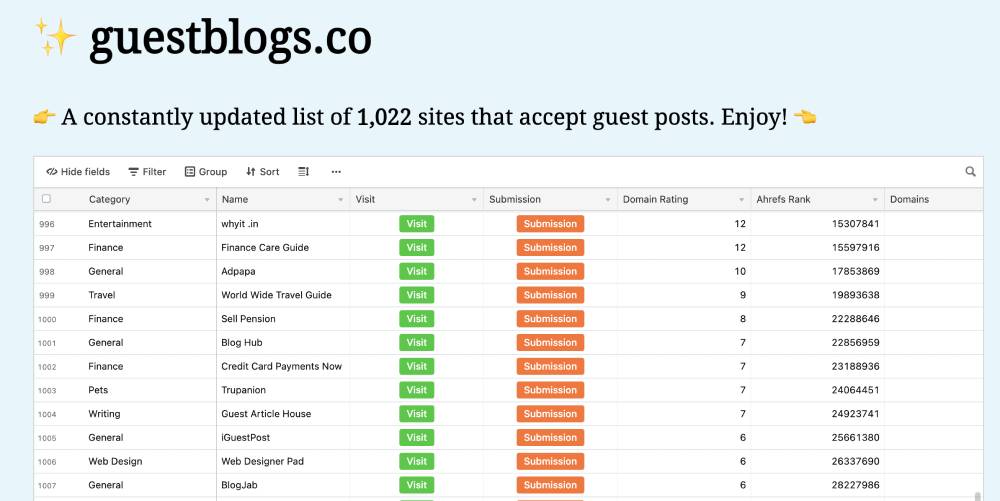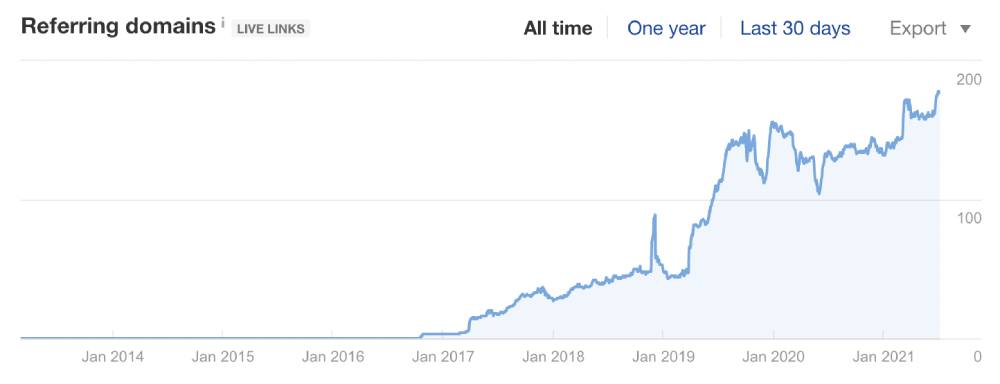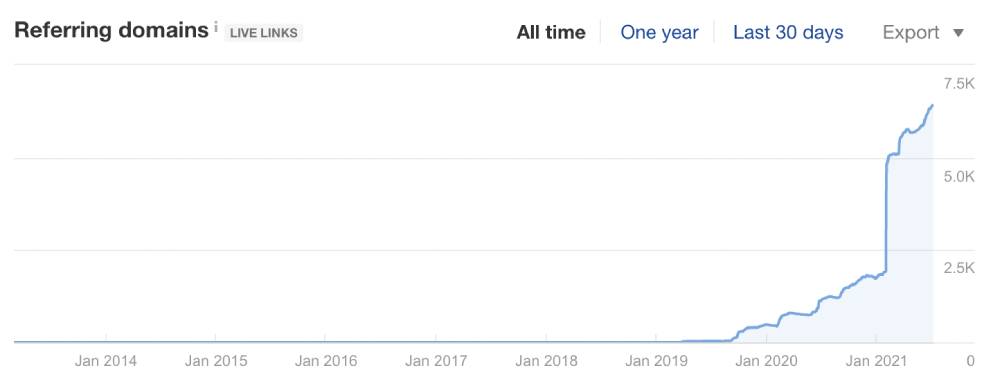I recently published another little side project, being a guest blogging list, featuring over 1,000 websites with reasonable metrics that allow guest posts. In building this list and collating all of the data for it, it made me think about what I look at, as far as metrics, before I find a website to pitch a guest post at.
I’ve included the various columns and data from Guestblogs.co here, with a description, so you can make your own call about what to look for, when trawling a guest blogging list such as mine.
I was lucky enough to have access to Ahrefs.com which is a very powerful software tool which allows me to research into each of the websites on this guest blogging list.
The reason we look at all of these metrics is that an inbound link isn’t all the same. For example, a link from Forbes.com would be far more valuable than a link from some unheard of personal blog with a domain rating of 1.
In fact, in some cases, backlinks from some sites can be considered poisonous, however Google is pretty good at working out which is which, and just ignoring the latter. In fact, a lot of experts now say that you don’t even bother with doing a disavowed links list, either.
When I set out to create a list of websites that accept guest posts, I didn’t want to reproduce every other guest blogging list out there. I wanted to choose sites that actually looked from the metrics at least, that were worthwhile approaching.
Whilst I think these sites are all pretty reasonable, I try and put the power in the readers hands, by providing a certain amount of metrics that they can use to value each website on its own.
This post goes through each of these metrics, and explains them in further detail.
Guest blogging list metrics
So the metrics that I decided were easy enough to include in Guestblogs.co are;
- Category
- Name
- Domain Rating
- Ahrefs Rank
- Domains
- Linked Domains
- Total Backlinks
- Total Keywords
- Total Traffic
- IP
So now, let’s go into each of these in some more detail, so you understand why I included them in my guest blogging list.

Category
This is my version of categorising the websites on this list.
Name
Put simply, this is just the name of the website.
Domain Rating
This is the Ahrefs domain rating, ranked out of 100. For example, a brand new website will have a rating of zero, and google.com has a domain rating of 98. The higher the domain rating, typically the more barriers to pitching a guest post and eventually getting it published.
It may be relatively easy to get published on a website with a DR of 5, and far different to getting published on a website with a DR of 55. Over time, for example, the 6Q blog has attracted more and more guest post pitches. We probably get 30-50 a week now, many very poor of course. We only publish two guest posts per week, so we’re picky about what we choose, and require a very high quality of writing.
Ahrefs Rank
This is where this site falls in the Ahrefs total database. Given that they have over 100 million sites, any number that’s only 5 or even 4 digits is pretty good. Incidentally, Ahrefs lets you download their top 1,000,000 websites here.
Domains
This is the amount of domains found that are linking to this website. These can be manipulated though, so it is worth looking at the overall growth of domains and inbound links if you’re able.
For example, here’s a graph from Ahrefs showing a natural growth of domains linking to a website over time.

You can see here that since early 2017, the amount of domains linking to this website have slowly but surely been increasing. Compare that to the below graph as a comparison.

This pales with the sudden jump in domain links, from less than two years ago until now. Apparently, in one month alone, this website built 2,500+ domains links to it.
Linked Domains
This is domains found that this specific website links to. You’d find in most cases, this figure is significantly less than the domains figure. If it were closer to equal, or worse, then that is a reasonably good sign that the domain is quite spammy, and accepts links from anyone. In that case, it’s probably worth not even bothering to submit a guest post.
Total Backlinks
This is the amount of backlinks that this website has pointing at it. This figure is always higher than the amount of domains pointing at it. For example, if I have three links on my domain pointing to your website, I would be one domain, but three backlinks.
Total Keywords
This is how many keywords that site is ranking for, in the first 10 pages (100 results) of Google. The higher the better, of course. The more keywords a site has ranking, the more you can trust that Google and other search engines feel it is a legitimate website, which is good.
Total Traffic
This is a very rough estimate of traffic to this website. I have found that this tends to be way off the mark. I have some sites that it shows as zero traffic that get a few hundred visitors a week, and others that show 100 when in fact it’s closer to 10 visitors.
IP
This is the IP address of the hosting server this site is on. The reason we include this, is to avoid situations where there are 100 sites on the same web server (so, same IP address) all linking to the same place. Google is smart enough to realise SEO manipulations like that, and discount them.
In Summary
So the metrics I look at, when choosing sites from a guest blogging list, to approach for guest posts, are;
- Category
- Name
- Domain Rating
- Ahrefs Rank
- Domains
- Linked Domains
- Total Backlinks
- Total Keywords
- Total Traffic
- IP
Good luck in finding opportunities for guest posts, and for avoiding the Google punishment for choosing the wrong places!








